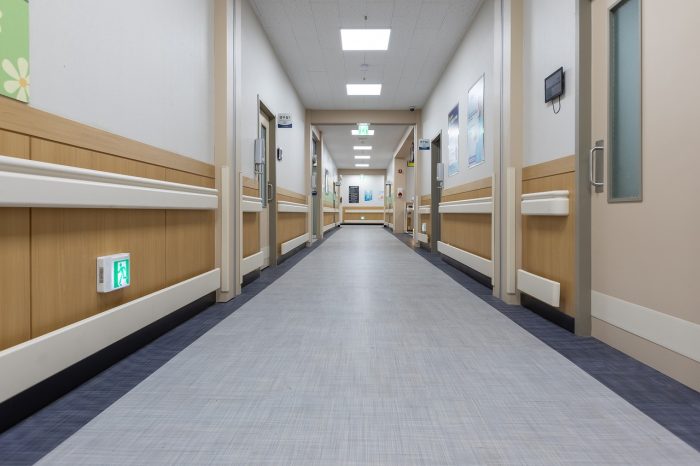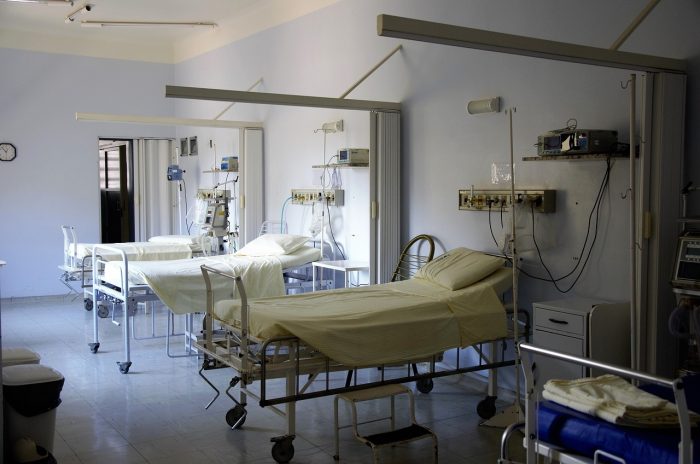
As a highly specialized field, plumbing design in healthcare facilities is essential for the comfort, efficiency, and cleanliness of patients and staff. Because of the delicate nature of their work, healthcare facilities have specific plumbing requirements. This includes long-term care centers (LTCs), clinics, and hospitals. In order to prevent harm to patients, employees, and visitors, these establishments must adhere to strict regulations.
Specialized drainage, waste disposal, water supply, and medical gas systems are just a few of the many functions performed by plumbing systems in healthcare facilities. All of these systems need to be well-planned so that they can withstand important medical procedures, keep patients comfortable, and adhere to regulations.
Key considerations in plumbing design for healthcare facilities include:
Given the unique requirements of a healthcare facility’s environment, careful plumbing design is of the utmost importance.
- Energy efficiency
- Install water recycling systems and water-saving fixtures to reduce water consumption.
- To lower the operating expenses of the facility, use pumps, water heaters, and other components that are energy efficient.
- Redundancy and reliability
- Redundant systems are necessary to provide ongoing operation in the event of failure for essential services, such as water for cooling systems and sterilization systems.
- In case of an emergency, make sure to have tanks or other sources of water on hand.
- Accessibility and maintenance
- Building plumbing systems to minimize downtime and invasive repairs is crucial.
- Without interfering with essential operations, designs should permit unhindered access to plumbing systems for repair.
- Scalability and flexibility
- The system should be able to easily incorporate any changes in healthcare delivery methods or new technologies.
- The design should be able to seamlessly incorporate any future additions or changes.
- Medical gas systems
- Codes and standards related to healthcare must be followed.
- To ensure the safe distribution of medical gases like nitrous oxide, oxygen, and vacuum systems, precise design and installation of specialized pipework is required.
- Temperature control
- In some parts of the building or in particular climates, pipes may be necessary to keep the temperature constant.
- Water should be reliable and properly tempered for various uses, including cleaning, sterilization, and medical care.
- Regulatory compliance
- It is important to adhere to all applicable health and safety laws, particularly those pertaining to construction and healthcare.
- The CDC’s infection control protocols, for example, should be followed.
- Patients’ and employees’ safety
- Facilities that handle potentially dangerous substances should prioritize the location and accessibility of emergency fixtures.
- In order to prevent slips and falls, the influence on flooring should be considered during plumbing design in areas prone to water spills.
- Waste and ventilation
- To avoid dangerous gas accumulation in drainage systems, proper venting is essential.
- The systems should safely handle both frequent hazardous biological waste and sanitary waste.
Water quality and safety
- To guarantee high-quality water, it could be required to install sophisticated filtration systems.
- Surgical and intensive care unit spaces, in particular, should be designed to reduce the likelihood of waterborne infections (such as Legionella).
- Make sure there’s always potable water that is free of pollutants.
The plumbing design must serve the facility’s healthcare purpose while ensuring safety, compliance, and efficiency, and these considerations make sure of it.

How to design plumbing systems for healthcare facilities?
Healthcare facilities must meticulously plan their plumbing systems to meet the specific needs of water supply, sanitation, and waste disposal in order to maintain patient hygiene and safety. This is a detailed guide:
- Medical gas and vacuum systems
- When planning the plumbing, be sure to account for medical gases such as compressed air, nitrous oxide, and oxygen.
- When connecting gas lines, use metals that are resistant to corrosion, such as stainless steel or copper.
- You should design central vacuum systems for patient care locations to guarantee the application of the proper suction during medical procedures.
- Understand codes and standards
- Understand requirements that are specific to healthcare.
- Research the plumbing codes in your area and country.
- Water supply system design
- A constant water pressure is essential for preventing backflow and ensuring an adequate supply, particularly in buildings with multiple stories.
- Consider how often you’ll be sterilizing, cleaning, or taking showers, and then size the hot water system accordingly.
- To ensure reliability, make sure there are two pumps and a backup water supply (such as a tank).
- Think about treatment technologies (such as softening or filtration) to make sure potable water satisfies all health regulations.
- Evaluate facility requirements
- Determine whether isolation rooms, sterilizing spaces, labs, and operating rooms require specific plumbing requirements.
- Calculate the amount of water and waste produced by making educated guesses about the number of patients and employees.
- Consider if it’s a specialized care unit, clinic, or hospital; the needs of each are distinct.
- Wastewater and drainage system
- Install floor drains in high-traffic areas (such as operating rooms and showers) to prevent water from pooling there.
- Ensure proper ventilation of the plumbing system to ensure smooth drainage and prevent traps from siphoning.
- Establish protocols for dealing with infectious waste generated in laboratories and isolation rooms, which frequently necessitates specific treatment prior to release.
- Construct a system that can remove waste from medical devices, toilets, and sinks.
- Infection control considerations
- By minimizing stagnant water and keeping water at the right temperature, hot water systems can reduce the risk of Legionella bacteria.
- Use hands-free toilets and faucets to reduce infection transmission.
- To avoid burns, put anti-scalding devices on faucets.
- Documentation and testing
- You must create a maintenance plan to guarantee regular repairs, cleanings, and inspections.
- Before the facility opens, a few systems need testing, including water supply analysis, leak detection, and pressure testing.
- Make detailed plumbing plans with all the necessary specs and isometric drawings.
- Planning for emergencies and redundancy
- Make sure there is enough water pressure and supply before installing the fire sprinkler system.
- In order to keep operations running during power outages, make sure that important plumbing systems feature backup generators and redundancy.
- Make sure that laboratories and other facilities that handle hazardous compounds have emergency fixtures installed.
- Sustainability and efficiency
- Look into ways to incorporate solar water heating into the hot water system to make it more energy efficient.
- For non-drinking purposes, such as irrigation, think about installing a graywater recycling system.
- To reduce usage, use water-efficient appliances and fixtures with low-flow models.
- Compliance and permitting
- Prior to beginning building, be sure you have all the required permits.
- Arrange for local authorities to conduct inspections at various points in the construction process to check for code and standard compliance.
- Collaboration with other disciplines
- To make sure the plumbing system works well with the rest of the building, you should collaborate closely with the medical equipment planners, HVAC experts, and architects.
- Post-installation monitoring
- Regularly inspect the plumbing system for any signs of issues and fix them.
- Regularly monitor the quality of the water to ensure that it meets healthcare requirements.
This method guarantees that a healthcare facility’s plumbing system is reliable, safe, and in line with all relevant legislation.
Benefits of installing high-quality plumbing systems for health care facilities
The health, safety, and general welfare of everyone at a healthcare facility—from patients to employees to visitors—depends on the quality of the plumbing system installed. Here are some of the main advantages:
- Staff and patient satisfaction
- When the plumbing systems are in good working order and can meet the needs of both staff and patients without interruption, there is a higher level of satisfaction.
- When patients and healthcare personnel can relax knowing that the plumbing system is secure and dependable, it creates a more pleasant atmosphere.
- Compliance with health and safety regulations
- To avoid closures, penalties, and legal trouble, it’s important to follow these regulations.
- To maintain a safe environment for both patients and staff, healthcare facilities must follow local, state, and national laws. A high-quality plumbing system can help with this.
- Benefits for the environment and sustainability
- Water-saving fixtures are an integral part of an efficient plumbing system. They help with sustainability initiatives and minimize the building’s impact on the environment.
- To further cut down on operating expenses, modern plumbing systems can be engineered to maximize energy efficiency, especially when it comes to heating water.
- Improved patient care
- Reliable plumbing systems consistently provide basic amenities like washing stations, flush toilets, and showers, increasing patient comfort and respect.
- It is essential to have a steady supply of water on hand for several medical devices, such as dialysis machines. For such machinery to operate as intended, a reliable plumbing system is required.
- Operational efficiency
- A strong plumbing system minimizes the chances of problems like blockages and leaks that might interrupt operations. This makes sure that everything operates smoothly in the facility.
- Investing in high-quality plumbing now will save you money in the long run by reducing water waste, emergency repairs, and maintenance expenses.
- Enhanced air quality
- A home with properly functioning plumbing prevents leaks and water pooling, which hinders the growth of mold and mildew. The result is improved indoor air quality, which is especially important in hospitals and other healthcare facilities.
- Reduction in healthcare-associated infections
- Properly designed water supplies prevent the growth of bacteria like Legionella.
- In order to sterilize medical equipment and reduce the risk of healthcare-associated infections (HAIs), an efficient plumbing system is essential.
- Infection control and prevention
- Implementing efficient waste disposal systems can prevent the spread of infectious diseases by reducing the likelihood of sewage contamination.
- A steady flow of potable water is essential for sanitation, medical procedures, and personal cleanliness, and this is only achievable with well-maintained plumbing.
A healthcare facility’s plumbing system has a direct bearing on patient outcomes and operational success because it ensures efficiency, safety, and cleanliness.
Disadvantages of having a poor plumbing system for health care facilities.
Negligent plumbing in healthcare facilities can lead to a number of major problems, including:
Health Risks to Patients
Patients are at a high risk of exposure to dangerous bacteria and other contaminants in the event of sewage spills or contaminated water.
Operational Disruptions
A plumbing disaster could severely disrupt regular facility operations. This can affect both routine everyday operations and crucial emergency procedures.
The safe and effective administration of patient care depends on a health care facility’s plumbing system, which must be well-maintained and dependable.
Cross-Contamination
Broken-down plumbing can lead to cross-contamination, making it particularly hazardous in patient care areas and operating rooms.
Water Shortages
A plumbing issue that results in an inconsistent or inadequate water supply could negatively impact medical processes and patient care.
Regulatory Compliance Issues
Strict standards govern plumbing and sanitation in healthcare facilities. Violations due to inadequate plumbing might result in penalties.
Insufficient Waste Disposal
The incorrect disposal of waste, caused by backups or clogs due to malfunctioning plumbing, can lead to the wrong management of biohazardous waste.
Increased Maintenance Costs
When plumbing problems arise frequently, repair and maintenance expenses can add up quickly, taking money that could be better spent on patient care.
Problems with Infection Control
Problems with water quality due to inadequate plumbing can spread diseases and infections, particularly in regions where sterile conditions are critical.
Conclusion
Creating efficient, safe, and compliant settings in healthcare facilities requires careful consideration of plumbing design, which is both complex and crucial. To guarantee the systems promote the health and safety of all individuals present, one must possess an in-depth familiarity with both the fundamentals of engineering and the unique requirements of healthcare operations.
